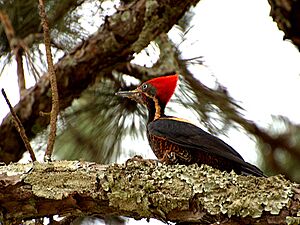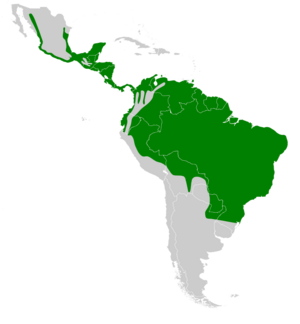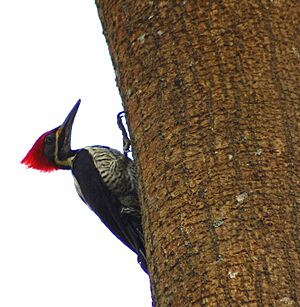Lineated woodpecker facts for kids
Quick facts for kids Lineated woodpecker |
|
|---|---|
 |
|
| Conservation status | |
| Scientific classification | |
| Genus: |
Dryocopus
|
| Species: |
lineatus
|
| Subspecies | |
|
5 subspecies, see text |
|
 |
|
| Synonyms | |
|
|
The lineated woodpecker (Dryocopus lineatus) is a very large woodpecker. This bird lives in many places, from southern Mexico all the way to northern Argentina and the island of Trinidad in the Caribbean.
Contents
About Its Name and Family
In 1766, a famous scientist named Carl Linnaeus gave this woodpecker its scientific name, Picus lineatus. The word lineatus comes from Latin and means "lined" or "marked with lines," which describes the white stripes on the bird.
Today, the lineated woodpecker is part of a group of birds called the Dryocopus genus. A genus is a group of closely related animals or plants. There are five different types, or subspecies, of lineated woodpeckers. These are like different versions of the same bird, often found in different areas.
Here are the five subspecies:
- D. l. scapularis: Found in western Mexico. These birds have less white on their faces and are a bit smaller. Their bills are usually pale.
- D. l. similis: Lives in eastern and southern Mexico down to northwestern Costa Rica. They also have pale bills and buffy (light brownish-yellow) underparts. They weigh about 136 to 181 grams.
- D. l. lineatus: This is the original type, found from Costa Rica to western Colombia, Trinidad, and parts of Brazil, Peru, and Paraguay. These birds have dark bills and weigh about 186 to 228 grams.
- D. l. fuscipennis: Found in western Ecuador and northwestern Peru. They are smaller than the original type and have browner feathers instead of black. Their bills are dark.
- D. l. erythrops: Lives in eastern Paraguay, northern Argentina, and southeastern Brazil. These are larger than the original type and have dark bills. The white lines on their shoulders are often smaller or missing, especially in southern areas. They weigh about 216 to 264 grams.
What It Looks Like
The lineated woodpecker is a big bird, about 31.5 to 36 centimeters (12 to 14 inches) long. It looks a lot like the pileated woodpecker found in the U.S. and Canada.
Most of its body is black, but it has a bright red crest on its head. It also has white stripes that start near its beak and go down its neck and shoulders. However, some birds in the southern part of their range might not have the shoulder stripes. Their undersides are whitish with many black stripes. When they fly, you can see white patches on their wings.
Male lineated woodpeckers have a red stripe from their beak to their throat and a red forehead. Female lineated woodpeckers have black in these areas instead of red. Both males and females usually have black beaks, but some can have pale beaks.
This bird makes a loud, clear call that sounds like wic-wic-wic. Both male and female woodpeckers also make drumming sounds by pecking on trees.
It can sometimes be confused with the crimson-crested woodpecker, which is similar in size and color. However, female crimson-crested woodpeckers have a much wider white face stripe. Also, the white lines on their shoulders meet on their lower back, forming a "V" shape. Male crimson-crested woodpeckers have almost entirely red heads, which makes them easy to tell apart.
Where They Live and What They Eat
Lineated woodpeckers like to live in the edges of forests and in open woodlands. They usually do not live in high mountains.
These woodpeckers dig holes in trees, often quite large ones, to find food. They mostly eat insects, like ants and their young, beetles and their young, termites, and caterpillars. They also eat some seeds, fruits, berries, and nuts.
Reproduction and Life Cycle
Lineated woodpeckers lay their eggs in holes they dig in dead trees. They usually lay three white eggs. Both the male and female birds take turns sitting on the eggs to keep them warm. They feed their young by bringing up food from their stomachs.
These birds breed at different times depending on where they live. For example, they breed from March to April in Panama, and from February to April in Trinidad. They dig their nests in dead trees, from about 2 to 27 meters (6.5 to 88 feet) above the ground. Both parents help dig the nest. The nests are about 45 cm (18 inches) deep and have an entrance about 9 cm (3.5 inches) wide.
They usually lay 2 to 4 eggs. During the day, males and females take turns incubating the eggs for 2 to 3 hours at a time. At night, only the male sits on the eggs. The baby birds are fed about once an hour by both parents. The female does most of the feeding, while the male often guards the nest.
Conservation Status
The lineated woodpecker is considered a species of "Least Concern" by conservation groups. This means that its population is stable and not currently at risk of disappearing. Scientists believe that the number of lineated woodpeckers is actually increasing in many areas. There are no major threats known for this bird right now.



